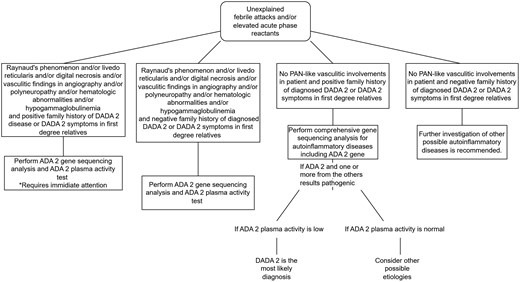-
Views
-
Cite
Cite
Admir Öztürk, Lara Yagci, Serdal Ugurlu, Mimics and challenging presentations of DADA2, Clinical and Experimental Immunology, Volume 219, Issue 1, 2025, uxaf017, https://doi.org/10.1093/cei/uxaf017
Close - Share Icon Share
Abstract
Deficiency of adenosine deaminase 2 (DADA2) has been a challenging diagnosis to make since it was first described in 2014. The disease represents a wide range of phenotypes. Therefore, it may present with various clinical patterns. Throughout the years, several difficult-to-diagnose cases of DADA2 were reported in the literature. Although several studies and reviews were published regarding different phenotypes and manifestations of DADA2, a review of challenging cases with diverse combinations of DADA2 manifestations was needed to integrate the knowledge from the literature into the clinical practice. Immunological, hematologic, autoinflammatory, and adult-onset polyarteritis-nodosa patterns were reported in the literature as cases challenging to diagnose. In this review, we aim to summarize the challenging case reports from the literature, provide an algorithmic approach for these kinds of presentations, and share our perspective and recommendations on the topic. Diagnosing DADA2 on time is a vital issue for preventing fatal and debilitating vascular events with anti-TNF-alpha therapy. Thus, early testing for DADA2 in suspected cases is recommended. Family history and genetic testing of the patient and the first-degree relatives are essential for accurate diagnosis. Thorough systemic examination and imaging might help detect clinically silent findings of vasculitis. Enzymatic activity of ADA2, when available, is also a key diagnostic tool that complements genetic testing and clinical evaluation.






